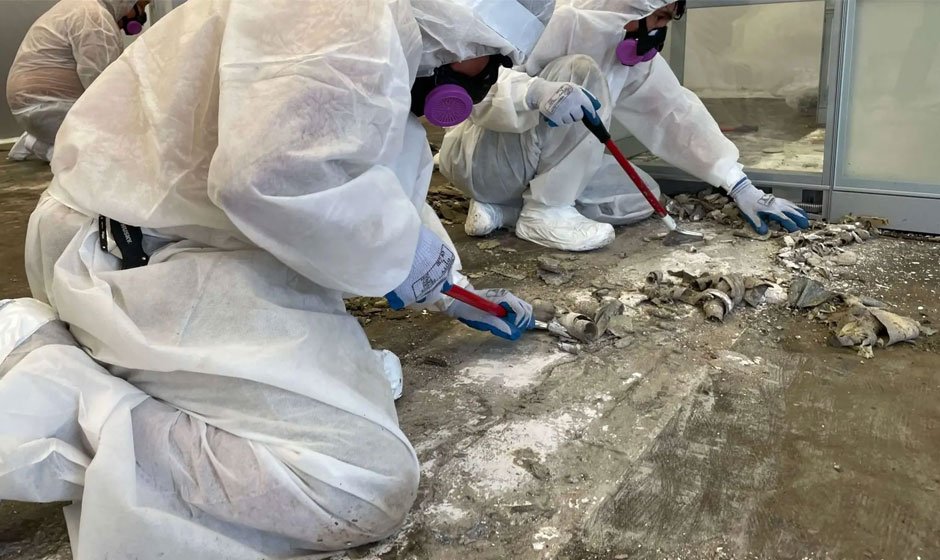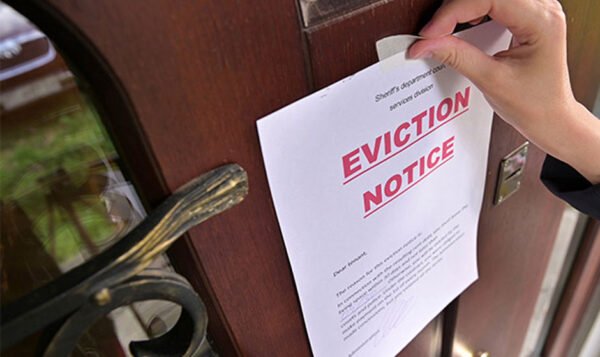The Importance of Professional Asbestos Removal Services

Asbestos Removal Process
The initial asbestos inspection and testing start the removal process. After that, we developed a detailed plan considering factors such as asbestos type and location. The asbestos removal and disposal are executed with utmost care to avoid asbestos cement and sheet breakage. Post-removal cleanup and air quality testing ensure a safe environment. Poor condition or demolition may require service work like a new roof. Adhering to UK HSE regulations and obtaining the necessary licenses is essential. Compliance with strict standards, including HSE guidelines and obtaining relevant licenses, is vital in the asbestos removal process.
Initial Asbestos Inspection and Testing
Before any service work commences, a comprehensive asbestos survey must be conducted to assess the poor condition of asbestos sheets or cement. Sampling and testing for asbestos are essential to determine the extent of exposure and comply with safety regulations. Identifying potential asbestos breakage during demolition or installing a new roof is vital. Thorough asbestos inspection is crucial not only for compliance with UK regulations but also for the safety of workers and occupants.
Development of an Asbestos Removal Plan
Planning for asbestos removal entails creating a comprehensive plan that details safe removal methods and necessary precautions. This includes using suitable equipment, personal protective gear, and compliance with local regulations. Additionally, it involves coordinating with relevant authorities to ensure a safe and efficient removal process with minimal exposure risks. Developing an asbestos removal plan is crucial for ensuring the safety of all individuals involved and for adhering to local authority regulations.
Executing the Removal and Disposal of Asbestos
Safe and effective asbestos removal involves employing licensed contractors and certified personnel. The process ensures minimal risk of exposure and contamination during the disposal of asbestos waste, conducted in compliance with relevant enforcing authority regulations. Utilising power tools and damp rags, asbestos removal execution prioritises control and cleanliness. Upon completion, a certificate of disposal for asbestos material is issued per regulations. This approach guarantees the safe and compliant removal and disposal of asbestos, which is essential for maintaining a healthy environment.
Post-removal Cleanup and Air Quality Testing
After completing the asbestos removal process, it’s crucial to conduct air quality testing to ensure its effectiveness. Thorough post-removal cleanup prevents lingering asbestos exposure and eliminates asbestos waste. Testing for airborne asbestos fibres is vital to certify an asbestos-free environment. This process is necessary to adhere to regulations and ensure the safety of the surrounding area.
Regulatory Compliance in Asbestos Removal
Compliance with asbestos removal regulations is crucial for ensuring the safety of workers and the public. The UK’s Health and Safety Executive (HSE) regulates asbestos removal activities and requires a specific licence for asbestos work. Failure to adhere to these regulations can result in severe consequences. Following the guidelines outlined in the HSE’s published documents, such as the Asbestos Essentials task sheets and the Control of Asbestos Regulations, is essential. Compliance with these regulations is imperative to prevent exposure to asbestos fibres during removal and disposal.
Importance of Adhering to Regulations
Compliance with regulations during asbestos removal is crucial for ensuring safe and lawful procedures. It minimises the risk of exposure, protecting against asbestos-related diseases. Adhering to rules also safeguards against unauthorised asbestos disposal, promoting responsible removal practices. This helps maintain public safety and environmental health. It’s essential to strictly follow regulations to prevent asbestos exposure and ensure reliable asbestos removal.
Consequences of Non-compliance
Non-compliance with asbestos regulations poses risks of hazardous exposure. Failure to adhere to rules can lead to legal consequences, including fines and penalties. It not only endangers public health but also jeopardises environmental safety. Poor compliance practices create health hazards for individuals and the environment, emphasising the importance of strict adherence.
Asbestos Training and Certification
They ensure the safety of individuals and the environment by obtaining a license from the HSE in the UK. Essential asbestos training for professionals. Recognising poor condition and breakage of asbestos sheets. Implementing safe removal practices to minimise exposure risk. Proper disposal and post-removal cleanup procedures. Compliance with regulatory requirements for asbestos removal services.
Essential Training for Asbestos Removal Professionals
Proper training for asbestos removal professionals includes:
- Handling and disposal of asbestos.
- Emphasising personal protective equipment.
- Understanding asbestos exposure and insulation.
- Educating on health risks from airborne asbestos fibres.
- Decontamination procedures.
It ensures safety during service work and demolition. This training is essential to meet the UK’s HSE regulations, obtain a license, and prevent breakage of asbestos sheets, especially in poor conditions. Compliance with HSE regulations is crucial for new roof installations.
Importance of Certification
Certification assures clients of the expertise and competence of removal professionals who adhere to industry standards and best practices. Clients seek certified asbestos removal experts for quality assurance, as certification demonstrates the capability to handle and dispose of asbestos safely. Additionally, employers prioritise certified professionals for asbestos removal projects, ensuring the safe handling and disposal of asbestos materials.
Asbestos Removal Equipment
Tools and Safety Gear for Asbestos Removal
Asbestos removal professionals rely on specialised equipment to safely and effectively eliminate asbestos hazards. Essential safety gear, such as protective clothing, gloves, and respirators, is crucial for safeguarding workers against asbestos exposure. Additionally, using specific tools designed for asbestos removal, including HEPA vacuums and wet removal systems, ensures the secure handling and disposal of asbestos materials. Advanced technology like asbestos fibre analysers and air monitoring devices further enhances the precision and effectiveness of the removal process, ultimately contributing to a safer work environment and improved air quality.
Tools and Safety Gear for Asbestos Removal
Utilising personal protective equipment like coveralls, masks, and gloves during asbestos removal is crucial. Additionally, the use of power tools and decontamination showers is essential. Specialised equipment such as HEPA vacuums plays a vital role in asbestos removal, while safety gear like respirators protects airborne asbestos fibres. Employing these tools and safety gear significantly minimises the risk of asbestos exposure during removal.
The Role of Technology in Asbestos Removal
Advanced technology is crucial in thoroughly planning asbestos removal, aiding sampling and analysis. This includes digital tools and analytics that enhance the detection and disposal of asbestos fibres, ensuring precise and efficient completion. Moreover, technology facilitates accurate asbestos surveys and removal work notifications, streamlining the process. This innovative approach significantly improves the quality and safety of asbestos removal services, benefiting workers and occupants.
Finding a Reliable Asbestos Removal Service
Ensuring the contractor holds a valid license and abides by asbestos regulations. Look for a company offering a certificate of disposal to guarantee proper handling. Consider the expertise and training of the removal contractors, as well as their use of appropriate personal protective equipment (PPE). Additionally, check if the contractor conducts an asbestos survey and provides a completion certificate, ensuring compliance with regulations and safety standards. This comprehensive approach is essential for reliable asbestos removal services.
Key Questions to Ask When Selecting an Asbestos Removal Service
When selecting an asbestos removal service, it’s essential to inquire about the type of work to be performed and the disposal process for asbestos waste. Ensure that the contractors have experience in asbestos garage roof replacement and removal. Verify compliance with local authority and environment agency regulations, and ask about measures to minimise asbestos exposure during removal. Additionally, request a quotation and notification of asbestos disposal from the service provider. These questions are crucial for selecting a reliable asbestos removal service.
Conclusion
In conclusion, it is crucial to prioritise licensed asbestos removal contractors to ensure your safety and that of your loved ones. Asbestos exposure poses severe health risks, and attempting to remove it yourself can lead to further complications. By hiring professionals, you eliminate the dangers associated with asbestos and benefit from their expertise and adherence to regulatory compliance. Professional asbestos removal services follow a meticulous process, from initial inspection and testing to the safe disposal of asbestos. Additionally, they have the necessary training, certification, and specialised equipment to handle the job effectively. When selecting an asbestos removal service, ask the right questions to ensure their reliability and expertise. Remember, the importance of professional asbestos removal cannot be overstated when safeguarding your health and well-being.



